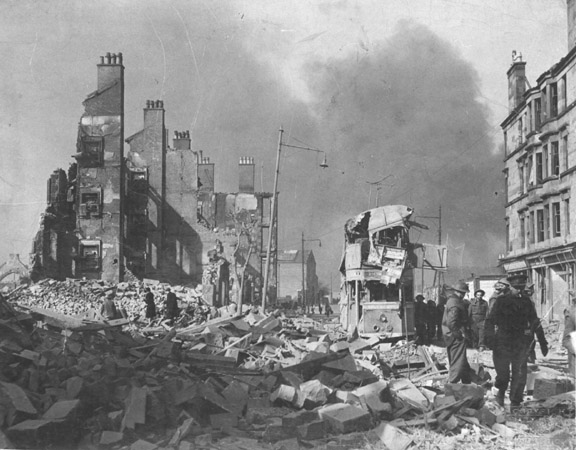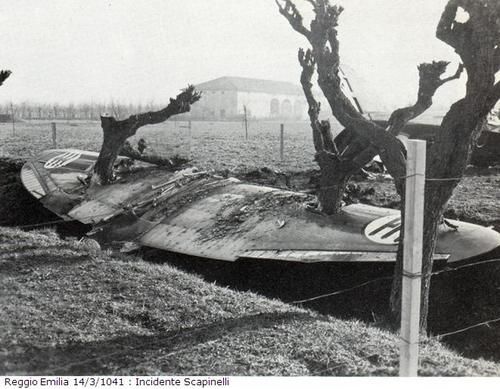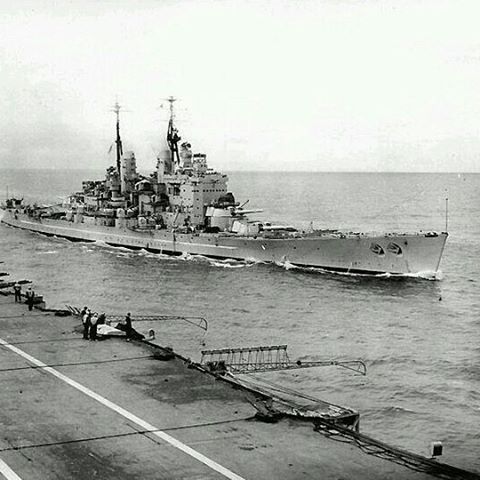Monday 24 March 1941
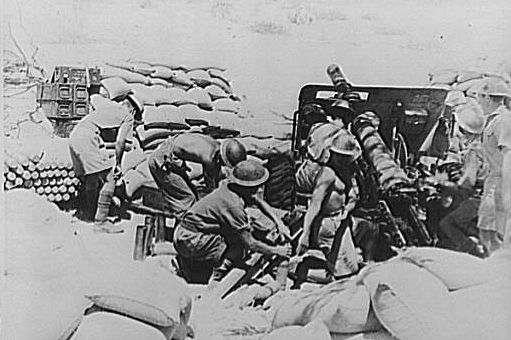 |
| Indian artillery troops at Keren, 1941. |
The diversion for the main attacks begins with an advance on Sanchil to the left of the gorge. After this progresses a bit, the main attack on the right of the gorge begins. This main attack is made by the West Yorkshires and the 3/5th Mahrattas, advancing from Fort Dologorodoc. They advance down the hill from the fort to take a lower feature that actually overlooks the gorge, Hillock A, as the day ends.
Much further south, the British Army completed the reoccupation of British Somaliland - whose conquest in August 1940 was the one real Italian military achievement of the war.
European Air Operations: RAF No. 82 Squadron of Bomber Command attacks shipping off the Norwegian and Dutch coasts during the day. They lose a Blenheim but sink a fishing trawler. Coastal Command raids Cherbourg right when a German military parade is in progress, somewhat spoiling the festivities as everyone has to scatter. The Luftwaffe remains quiet, with a few random attacks by lone raiders in Kent and South Wales.
RAF ace James Lacey, flying a Supermarine Spitfire Mk II fighter, damages a German fighter.
The Royal Navy remains obsessed with German cruisers Gneisenau and Scharnhorst, which the Admiralty now realizes have made port in Brest. The British detail aircraft carrier HMS Ark Royal and battlecruiser Renown from Gibraltar to sit outside the port waiting for them to depart. A rotating cast of destroyers supports them.
The Commander-in-chief Fleet Home Fleet Admiral Sir John Tovey transfers his flag from HMS Nelson to Queen Elizabeth.
The Luftwaffe bombs and damages 461-ton Royal Navy anti-submarine yacht HMT Wilna at Portsmouth. The ship is abandoned and written off. There are no casualties.
Italian submarine Veniero torpedoes and sinks British 2104-ton freighter Agnete Maersk in the mid-Atlantic southwest of Ireland. The Agnete Maersk is part of Convoy OG-56. Everybody perishes.
U-97 (Kptlt. Udo Heilmann) also attacks Convoy OG-56. It sinks 4301-ton Norwegian freighter Hørda. There are no survivors from this ship, either, all 30 aboard perish.
U-106 (Kptlt. Jürgen Oesten) torpedoes and sinks 4267-ton British freighter Eastlea. The ship's back is broken by the torpedo and it sinks within ten minutes.
Royal Navy destroyer HMS Mansfield loses all engine power and has to be towed to port. It is out of service for ten days.
Royal Navy armed boarding vessel St. Day collides with 3276-ton Spanish freighter Gayarre in the Straits of Gibraltar. The St. Day has to return to Gibraltar.
Norwegian tanker Polykarb, captured by the Gneisenau, arrives in the Gironde. The other captured ships haven't made it, intercepted by the Royal Navy and scuttled by their crews.
Minelayer HMS Abdiel, escorted by destroyers Kashmir and Kipling, lays minefield GV in the English Channel.
Convoy WS (Winston Special) 7 departs from the Clyde with 21 transport ships each of 20,000-30,000 tons. However, two of the transports, 22,281-ton HMT Strathaird and 25,550-ton Stirling Castle, collide and must return to the Clyde.
Convoy OB 302 departs from Liverpool, Convoy HG 57 departs from Gibraltar.
Adolf Hitler has ordered Lieutenant General Erwin Rommel not to attack - so he does anyway. At 06:00, the advance begins. By 07:30, the 3rd Reconnaissance detachment of the 5th Light Division of the Afrika Korps occupies El Agheila at the extreme west of the British conquests against light opposition. The British destroy the lead German armored car, then withdraw. The Germans do lose two tanks damaged to mines. Rommel uses one of his typical ruses, sending dummy tanks out on Volkswagen chassis to raise up a lot of dust and make it look like an entire panzer army is on the way.
Rommel comments:
The garrison, which consisted only of a weak force, had strongly mined the whole place and withdrew skilfully in face of our attack.The green 2nd Armoured Division, which has replaced the veteran 4th Armoured Division due to the latter's transfer to Greece, gives ground rapidly. To be fair, the British in El Agheila are under orders to retreat if attacked. Nobody thinks that a British armored division, no matter how green, is full of cowards: many such incidents on both sides are due to blind caution at the higher levels ("REMFs," for those who understand military slang).
The British retreat to Marsa Brega 30 miles behind El Agheila. The Luftwaffe attacks it there, losing a Bf 110 to antiaircraft fire.
The Afrika Korps command squadron advances east of Nofaliya (Nawfaliya).
After dark, the RAF bombs Sirte. The attack kills 15, with 32 wounded, including 2 German soldiers.
Italian 633 ton freighter Nuraghe founders off Capo Pali, Valona, Albania. The cause of the sinking is described as a "marine accident."
Axis convoys have been getting through from Naples to Tripoli without many incidents. Royal Navy submarines know the route well, but so far they have had few successes. Today, the streak continues, as Royal Navy submarine HMS Ursula attacks a convoy off Cape Bon - but misses. As Rommel well knows, his success in the desert depends upon the successes or failures of the Royal Navy off Tripoli, so advances in the coming days can be partially attributed to this failure.
At Malta, the convoy that arrived on the 23rd remains in port. This requires constant patrols at full strength above the island. Coupled with the heavy recent RAF losses, this is imposing a strain on both the equipment and the pilots. The situation also is affecting the local population, who are cautioned to cease looting downed Luftwaffe aircraft - of which there have been many recently. Over the past two days, the Luftwaffe has lost 14 planes (almost all Junkers Ju 87 Stukas) while the RAF has lost only 6 or 7 - but the RAF has far fewer planes at its disposal than the Germans.
The Luftwaffe bombs the dockyards at dawn, causing some damage. There is one fatality and three wounded among the antiaircraft gunners, no losses by the Luftwaffe. In the afternoon at 18:25, the Luftwaffe returns with a bombing run by 10 Junkers Ju 87 Stukas on Grand Harbour. The Germans lose a Stuka this time, with three reportedly damaged.
Royal Navy submarine HMS Rorqual lays mines west of Sicily.
 |
| Hawker Tornado P5224, March 1941. |
Convoy BN 21 departs from Aden, Convoy BS 21 departs from Suez.
Turkish/Soviet Relations: Both the USSR and Turkey pledge to remain neutral if the other is attacked. The superficial fear by both is that the other will take advantage of German aggression to settle long-standing scores. The real underlying concern is by Turkey, which fears being attacked by Germany, but the treaty will come in very handy for the USSR.
Anglo/Yugoslav Relations: The diplomatic center of the world has shifted to Belgrade. Both sides are trying to alternately cajole and threaten the Yugoslavs to side with them - or else. Today, London gives a warning.
 |
| Life Magazine 24 March 1941, "Spring Veils," Designer Sally Victor. |
War Cabinet [meeting] chiefly about Ireland, but also rendered gloomy by reports from Jugo-Slavia, Turkey and Spain. The Irish position grows intolerable. Winston summed up - "700 years of hatred, and six months of pure funk."US Government: The US Senate passes President Roosevelt's $7 billion appropriations request for Lend-Lease.
China: The Battle of Shanggao heats up again after a very brief lull. The Japanese make an all-out assault on the Japanese lines, while the Chinese throw everything they have to stop them. There are tremendous casualties on both sides, with nobody really sure how many died or whose side suffered more. Last-minute Chinese reinforcements, brought in by Chinese General Zhu Xiang, turn the tide. As on the other side of the world in Albania, the lines remain the same at the end of the day, but the rivers of blood on the ground tell the tale.
American Homefront: "Native Son," written by Paul Green and Richard Wright, premieres at the St. James Theatre on Broadway. Orson Welles and John Houseman produce the play, which stars among many others Welles protege Ray Collins (of "Citizen Kane") and Francis Bavier. You may recognize that latter name but not be sure where you know it from. Aunt Bee. Mayberry. Enough said.
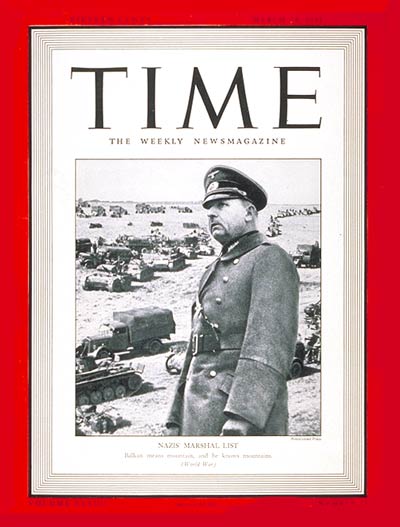 |
| March 24, 1941, | Vol. XXXVII No. 12. Field Marshal List is the commander of German forces in Bulgaria. His forces are poised to invade Greece (Cover credit: AP). |
March 1, 1941: Rettungsboje
March 2, 1941: Oath of Kufra
March 3, 1941: Germans in Bulgaria
March 4, 1941: Lofoten Islands Raid
March 5, 1941: Cooperation With Japan
March 6, 1941: Battle of Atlantic
March 7, 1941: Prien Goes Under
March 8, 1941: Cafe de Paris
March 9, 1941: Italian Spring Offensive
March 10, 1941: Humanitarian Aid
March 11, 1941: Lend Lease Becomes Law
March 12, 1941: A New Magna Carta
March 13, 1941: Clydeside Wrecked
March 14, 1941: Leeds Blitz
March 15, 1941: Cruisers Strike!
March 16, 1941: Kretschmer Attacks
March 17, 1941: Happy Time Ends
March 18, 1941: Woolton Pie
March 19, 1941: London Hit Hard
March 20, 1941: Romeo and Juliet
March 21, 1941: Plymouth Blitz
March 22, 1941: Grand Coulee Dam
March 23, 1941: Malta Under Siege
March 24, 1941: Afrika Korps Strikes!
March 25, 1941: Yugoslavia Joins The Party
March 26, 1941: Barchini Esplosivi
March 27, 1941: Belgrade Coup
March 28, 1941: Cape Matapan Battle
March 29, 1941: Lindbergh Rants
March 30, 1941: Commissar Order
March 31, 1941: Cookie Bombs
2020



